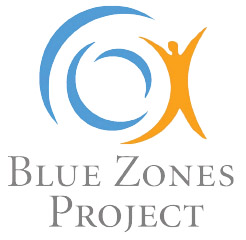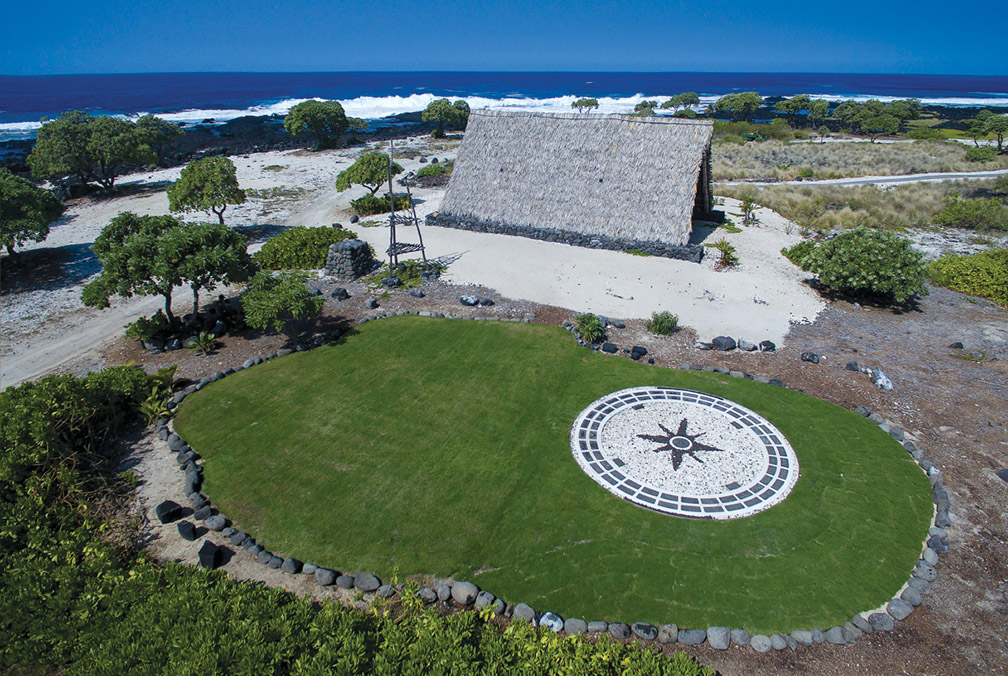
Kohanaiki: Connecting the Past to the Future

By Jan Wizinowich
Tutu Papa moves quietly in the dark of his Kohanaiki mauka hale (mountain-side home) in final preparations for a makai (ocean-side) gathering journey, collecting the supplies he will need for the day and a lunch of dried fish and poi.
He heads down the lava-strewn trail lit by the first rays to peak over Hualālai. Almost to the shore, he stops at a pond to collect ‘ōpae ‘ula, small shrimp that he will use for bait. He stops to observe the north and south currents facing off, a restlessly undecided ocean and moves south to fish.
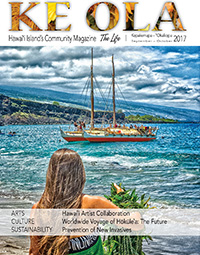
Historically Kohanaiki makai, the coastal section of the North Kona ahupuaʽa of the same name, was a gathering place for shoreline fishing, salt collection and gathering ‘ōpae ‘ula from anchialine ponds by ahupuaʽa (land division) residents. Reggie Lee, park cultural advisor, lineal descendant and son of recently passed master weaver, Elizabeth Lee remembers, “My mom’s story is, they used to come down here and fish. We were shoreline fishermen. They would use the anchialine ponds as refrigerators to keep their food cool and fresh. They used to dry and salt the fish out on the pahoehoe pōhaku (lava rocks). They’d go up on a donkey. My grandfather used to trade all the way up to Kalaoa. We even dyed our own net using the bark of the kukui tree. We wanted it dark brown or red to camouflage it.”
Formerly known as Pine Trees, the popular surfing area came under threat in the late 1980s with the proposal of a large resort development. The community activated with the goal to keep the area open and accessible. “First we formed a grassroots surfersʻ group, the Friends of Kohanaiki. We didn’t know all the buttons to push to fight something that big. We were working on keeping the beach jeep trail access open,” said original Kohanaiki ʽOhana member and North Kona County Councilwoman, Karen Eoff.
One day Karen and husband Gary Eoff met Angel Pilago. “We met Angel and his wife Nita at the beach. Angel is a visionary and a strategist and he knew about the work that Native Hawaiian Legal Corporation (NHLC) and Earth Justice were doing. He became president of the Kohanaiki ʽOhana and navigated us through the legal battles,” said Karen.
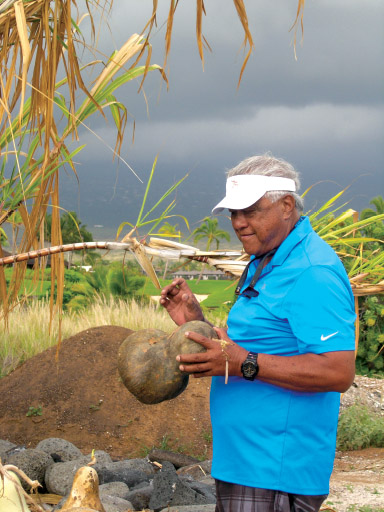
Under Angel’s leadership came two landmark Supreme Court victories reaffirming the impact of any development on the gathering and usage rights of Native Hawaiians, as well as the environment, must be taken into consideration. Following these decisions in 2000, Hawaiʽi State Legislature adopted Act 50, which requires a cultural impact statement as well as an environmental one for all future land use decisions.
Professional legal support in combination with an activated community eventually won the day. Rebecca Villegas, Kohanaiki ‘Ohana’s current president, was born and raised in Kona and grew up at Kohanaiki. Rebecca was already speaking out about it as a young teen. She recalls, “when I was 14 years old I gave a speech to the panel requesting that efforts be made to protect Kohanaiki. Growing up at Kohanaiki, it has been a place where I’ve celebrated my own birthdays and my family’s birthdays. I raised my daughter there. It’s a grounding place, not only for myself but for the whole community.”
In 2001, Harry Kim brought all the stakeholders to the table and after two years of meetings, a good faith agreement was forged. The zoning changed from resort to open space along the shoreline, with the developer donating 100 acres to the County of Hawaiʽi for the creation of Kohanaiki Beach Park.
Since that time the corporate entity, now Kohanaiki Shores, has honored the agreement, creating a public park along the shoreline with camping, bathrooms, and showers. They have also complied with the highest standards of environmental protection, creating an Audubon award winning sanctuary for such endangered birds as aeʽo (Hawaiian stilt) and ‘ewa‘ewa (Hawaiian sooty tern).
Not Your Ordinary Beach Park
Although many changes have taken place since Kohanaiki mauka residents traveled to the shore for sustenance, today Kohanaiki is carrying on as a valuable community resource, and for the perpetuation of Hawaiian cultural practices and sustainability.
Turn off the traffic-choked Highway 19 south of the Keahole-Kona Airport and one is immediately plunged into an eye-of-the-storm calmness. Turning right at the stop sign, the road, lined with great heaves of lava, winds towards the sea, eventually curving south and running parallel to the shoreline. A series of campsites are tucked under the numerous tree heliotrope. A little further on, a large group of young surfers ride the southern summer swells while parents are watchful on the shore.
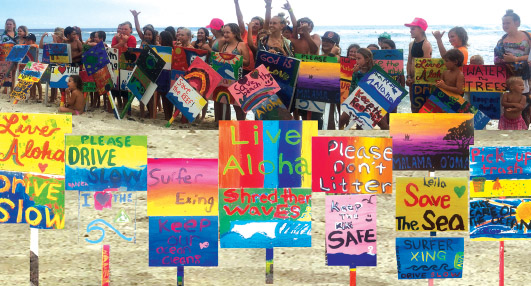
Colorful hand-painted signs with reminders to take care of the beach, drive slowly and live with aloha line the entry drive, compliments of Keiki Surf for the Earth, a contest for youth 14 and under, now in its 22nd year.
It is not just about surfing, though. “Kids have access to a space that is safe and healthy where they can learn and grow and have an understanding of their kuleana (responsibility). They clean up marine debris, take care of the reef ecosystem and learn how to conserve water and reduce one-use plastics,” said Rebecca.
The road ends and a foot path continues past the hālau, Ka Hale Waʽa, today having its thatching repaired. An ahu and lele (two altars) stand south of the hālau and form the entrance to a 17-foot diameter star compass, designed by Gary Eoff and Kālepa Baybayan, and used to teach wayfinding.
Drawn to the star compass’s connection to canoe culture, Kumu Keala Ching brings kūpuna (elders) to the park. “I brought kūpuna down to learn about the dial itself, the movement, the celestial stars summer solstice and winter solstice and to bring information to our people by learning about the area,” said Kumu Keala.
Beyond the star compass is the canoe garden backed by some of the 200 anchialine ponds that dot the area. Carved out of a space once choked with fountain grass and naupaka (native shrub), the canoe garden contains large patches of gourds, sweet potatoes and kalo (taro).
Besides providing sustenance and materials for the creation of traditional implements, the garden is a living laboratory of sustainability that teaches novices by allowing them to plunge their hands into the soil and life’s mysteries hidden there.
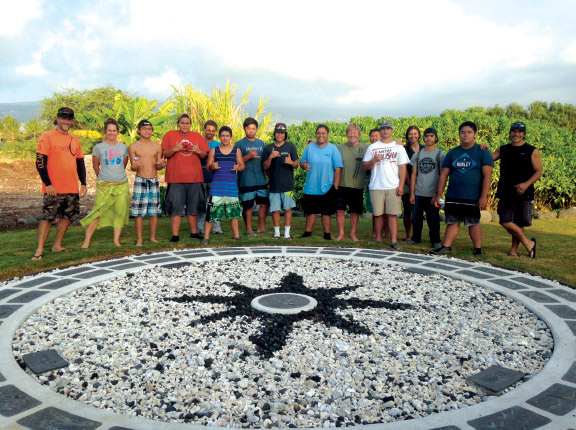
A Learning Laboratory
Kohanaiki Beach Park provides an ideal setting for students to engage in authentic cultural and environmental learning. Neighboring Innovations Public Charter School has a biannual hands-on science program at the park. “We incorporate a lot of ethnomathematics into our curriculum. Cordage and cordage-making are one of the corner stones of our science curriculum,” said Meg Dehning, Innovations middle school teacher.
The students experience a combination of hands-on engagement to learn about environmental science, cultural practices and give back with service work. “They had an opportunity to learn about the culture/ecological heritage of that particular section of the coastline. The students got to do lauhala weaving with Aunty Elizabeth Lee, learn to strip hau and took part in the ceremony for the star compass that was presided over by Kālepa Baybayan,” said Meg.
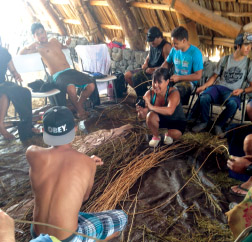
Service learning allows students the chance to give back at the same time they were receiving. “They really liked the hands-on work, especially when it came to learning to weave from Aunty Elizabeth or clearing the pond or helping dig the garden. It gave them the opportunity to learn in an authentic way. These are things that you just can’t teach in the classroom,” said Meg.
Another regular group at the park is Lanakila Learning Center, an alternative high school program in Hilo. Their environmental science curriculum involves what director Wendy Hamane calls full circle learning. Students teamed up with Gary Eoff to propagate, harvest, process and use ‘ie‘ie, a vine that grows on ‘ōhiʽa trees and is traditionally used for weaving and cordage.
“Realizing how much work went into gathering the leaves, cleaning and stripping and the whole thing. They understand the hard work that goes into it and they really appreciate the manaʽo (meaning) that’s passed down by cultural practitioners because they’ve been on the receiving end of it. A whole different level of appreciation,” said Wendy.
Next year’s program will focus on fiber art and cordage. “We hope to help them with their cordage garden. Gary’s going to teach the kids how to make cordage out of hau and coconut husk and hopefully the kids can help weave the hau to make the entry rope for the front of the hālau and to learn to lash the double-hulled canoe that they’re in the process of building,” said Wendy.
A Win-Win Model for the Future
The Kohanaiki Beach Park provides a sense of place and connectedness to the past and the future. It’s an example of what can be done when people bring their best intentions to the table. Kohanaiki ʽOhana’s president, Rebecca Villegas reflects, “The park is a model for a better community where the shore remains for and by the community, and managed by a consortium of county, community and developer representatives. The vision is that the model be perpetuated elsewhere. The coastline must be available for everyone.” Mahalo to all those whose kōkua (care) has seen to it that Kohanaikiʻs future is protected for future generations. ❖

